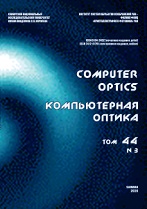|
This article is cited in 2 scientific papers (total in 2 papers)
IMAGE PROCESSING, PATTERN RECOGNITION
Correction of rotational blur in images of stars observed by an astroinertial attitude sensor against the background of the daytime sky
N. N. Vasilyuk
Electrooptika, LLC, 107076, Moscow, Russia, Stromynka, d.18, k.1
Abstract:
A rotational blur correction algorithm is considered as the initial stage of image processing in the problem of attitude measurement using a star tracker. To implement this algorithm, the star tracker must be equipped with a three-axis gyroscope. The algorithm does not guarantee the detection of an image of a star against the background of the daytime sky in one frame but facilitates conditions for subsequent image stacking. The correction aims to localize energy maxima of the blurred star images in pixels with predetermined characteristics. The correction highlights these pixels against the background and improves the signal-to-noise ratio, though deteriorating the artistic quality of the whole digital image. The key characteristic of the pixel of maximum localization is that it is where the geometric image of the star is found at the start of the exposure of the frame under correction. The correction is performed in the form of frame processing with a digital finite-impulse-response (FIR) filter. The impulse response of the filter is inhomogeneous and represents a core of rotational blur, synthesized in each pixel of the corrected frame. Algorithms for calculating levels of the signal, background, and noise in the image of a star observed against the background of the daytime sky with a rotating camera are described. Dependences of the signal-to-noise ratios in various pixels of a blurred image on the exposure time and on the angular velocity of the camera rotation are analyzed. The signal-to-noise ratios in the star image before and after the blur correction are calculated. The simulation results are illustrated by the example of an image of a bright star, clearly showing specific features of the proposed rotational blur correction algorithm.
Keywords:
daytime star tracker, gyroscope, daytime sky, rotational blur, blur correction, matched filter
Received: 04.04.2022
Accepted: 20.07.2022
Citation:
N. N. Vasilyuk, “Correction of rotational blur in images of stars observed by an astroinertial attitude sensor against the background of the daytime sky”, Computer Optics, 47:1 (2023), 79–91
Linking options:
https://www.mathnet.ru/eng/co1105 https://www.mathnet.ru/eng/co/v47/i1/p79
|

|




 Contact us:
Contact us: Terms of Use
Terms of Use
 Registration to the website
Registration to the website Logotypes
Logotypes








 Citation in format
Citation in format 
